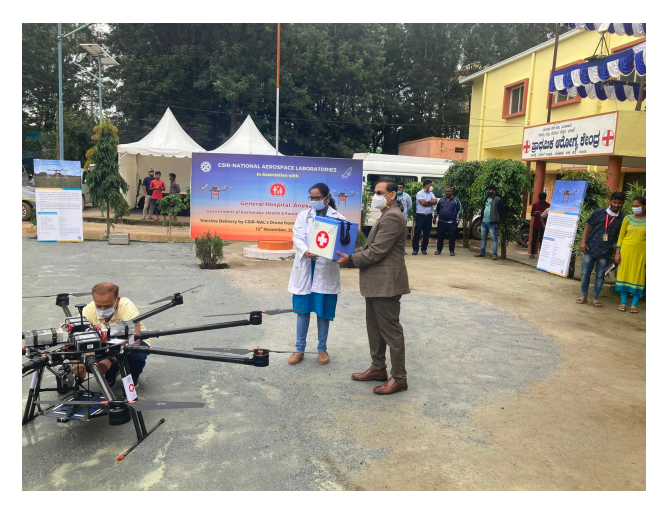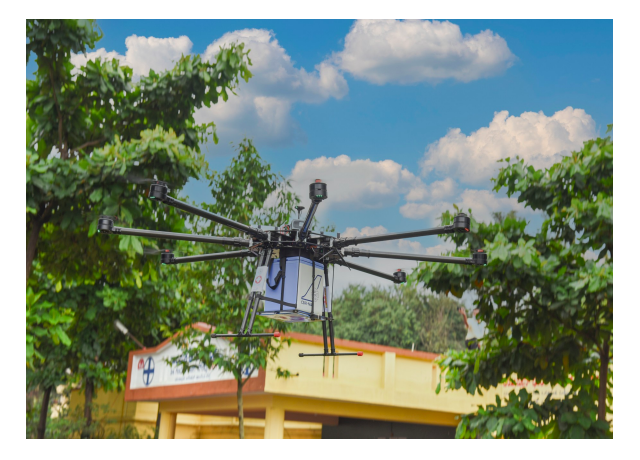Multicopter DRONE is designed and developed by National Aerospace Laboratories- NAL.
Bengaluru, NFAPost: National Aerospace Laboratories (NAL), a research laboratory under CSIR, has indigenously developed a medium class octacopter unmanned ariel vehicle (UAV) and successfully delivered Covid-19 vaccine in the outskirts of Bengaluru city.
The UAV, an octacopter with BVLOS (Beyond Visual Line of Sight) feature, is made out of lightweight carbon fiber foldable structure for ease of transportation and has unique features like autonomous guidance through dual redundant MEMS-based digital Autopilot with advanced flight instrumentation systems.
Ministry of Civil Aviation granted conditional permission to CSIR-NAL for conducting BVLOS flight trials on 13th September 2021. The octacopter UAV is small in size and it is a remote-controlled aircraft like helicopter, with eight blades that will help it go around on top.
CSIR-NAL has teamed with Karnataka Department of Health & Family Welfare for aerial delivery of covid-19 vaccine in a remote area. The octacopter has successfully delivered 50 vials of Covid-19 vaccines along with syringes in a special container from Chandapura PHC to Haragadde PHC on 13th November 2021.

Expressing happiness over the achievement, CSIR-NAL Director Jitendra J Jadhav said this is a great success story for NAL in its journey to develop drones with multiple used cases.
“NAL is working on its efforts to develop multiple drones for various used cases. NAL has gained capabilities in developing flying machines that have both civilian and military applications. Drones will open up new opportunities as India is looking at connecting various remote parts of the country and these drones will have application not only in health care but also in agriculture, surveillance, disaster management etc,” said CSIR-NAL Director Jitendra J Jadhav.
NAL’s octacopter can carry a payload of 15 kg with a hovering endurance of 40 minutes. It can fly at an operational altitude of 500 m AGL and at the maximum flying speed of 36 kmph. Its regulatory compliance includes DGCA-NPNT, Geo fencing and digital sky with 360 degree Collison avoidance making it one of the best UAV in its class.
Octacopter developed by NAL can be used for a variety of BVLOS applications for last-mile delivery like medicines, vaccines, food, postal packets, Human organ’s etc.
Congratulating his team for their stupendous efforts, CSIR-NAL Unmanned Ariel Vehicle (UAV) Head Dr. P V Satyanaraya Murthy said that the Octacopter for delivery of vaccines is a need of the hour of the country for much deeper penetration of vaccines in the remote areas.
“NAL octacopter is perfectly designed for such a mission with easy to operate by unskilled operators. NAL has already tied up with private firms for drone manufacturing and offering operational services,” said CSIR-NAL Unmanned Ariel Vehicle (UAV) Head Dr. P V Satyanaraya Murthy.

NAL Octacopter is integrated with powerful onboard embedded computer and latest generation sensors for versatile applications like agricultural pesticide spraying, crop monitoring, mining survey, magnetic geo survey mapping etc.
CSIR-NAL’s octacopter took off at 9.43 am from Chandapura PHC carried covid-19 vaccines and delivered to Haragadde PHC at 9.53 am.
Octacopter has flown at an altitude of 300m AGL at a speed of 10m/sec and covered an aerial distance of about 7 kms in about 10 minutes . After delivery of vaccines at Haragadde the octacopter returned back to Chandapura PHC .
The entire mission has covered a distance of about 14 km in 20 mins including delivery of vaccines. Medical Officer Dr Manisha said that usually it takes about 30-40 minutes to deliver vaccines to Haragadde from Chandapura by road. NAL initiative helped the doctors at PHCs to receive the medicine fast and safe via aerial delivery.
Dr Srinivas, DHO, Dr. Vinay, THO and Dr. Nalini, AMO, General Hospital, Anekal expressed their happiness and complimented the great initiative of CSIR-NAL towards the societal cause and extended support to continue the joint initiative to farthermost remote places in the coming days.





